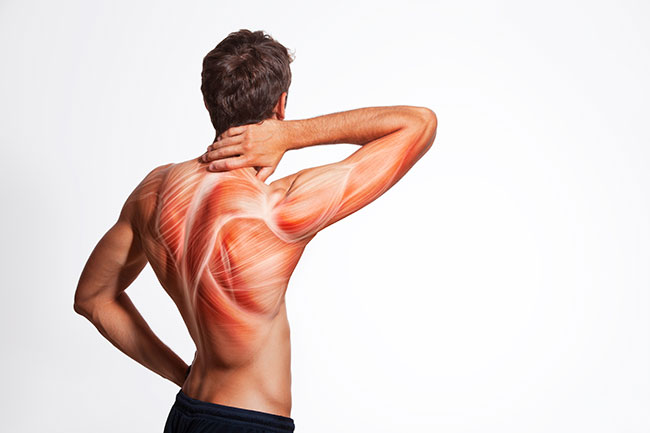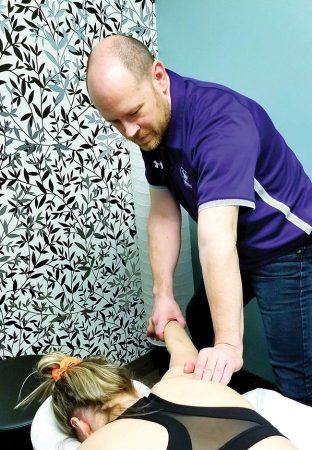
Features
Train safely to avoid pain
Firefighters need to be aware of the particular areas that are prone to injury in fire fighting.
October 30, 2019
By Chris Semenuk
 Recent research shows rotator cuff injury is most common amongst young firefighters, and more likely to be the first injury to occur.
PHOTO BY VFRSADOBE STOCK
Recent research shows rotator cuff injury is most common amongst young firefighters, and more likely to be the first injury to occur.
PHOTO BY VFRSADOBE STOCK In a December 2017 study from Western and McMaster universities of 294 active-duty firefighters in Hamilton, Ont., it was determined that 70 per cent experience pain or injury of some kind. Researchers also found that, over the age of 42, the chances of neck or limb pain double, and neck pain quadruples. The study, titled Prevalence and distribution of musculoskeletal disorders in firefighters are influenced by age and length of service, states that rotator cuff injury is the most common in younger firefighters (making it more likely to be the first of the injuries experienced).
This likely does not come as a surprise to anyone who lives with these aches/pains/injuries. What do we need to do to look at preventing these from occurring, or reducing their intensity/prevalence? As both a university level track and field coach and registered massage therapist, I approach this from a unique position.
Since 2001, I have been helping track and field and cross-country teams at Western University figure out ways to keep our injuries down and our performances high. I look towards the athlete’s future, meaning that I actually want them to have a future that does not include taking aches and pains with them from their time in university athletics.The training, the recovery, and the personal care need to be balanced. These principles also apply well to physical jobs like fire fighting.
The first concept that I try to instill to ensure balance is that rest and sleep are very important to maintaining health. The rest/digest phase of training is an integral part of training, indicates research in an article called Recovery in Training: The essential ingredient published by Jonathan N. Mike and Len Kravitz. Good sleep is one part of it, but so is taking actual downtime. The key to this concept is to realize that resting one’s conscious brain/body increases the activities of repair. This means that all the activity that we put our bodies through to get stronger requires the rest phase to actually repair the micro-damages done.
This applies to firefighters as they are continuously putting their bodies through significant strain. It’s important that firefighters train regularly to safely perform the specific tasks that they will have to do in the course of their job. When organizing a training week for athletes, we alternate “hard” and “light” days, which can help decrease risk of injury. The hard days are when we hit the gym and the track. The light days involve slowing it down so that the long runs are slow enough to carry on a conversation without effort.
We also do mobility drills that move the joints with very little effort to maintain and promote their overall health. This focus is designed to help prevent injuries and pain by allowing the body to have a rest while maintaining some form of activity as well. It is important that the training that occurs on the hard days is tailored to your needs. Aim for a level and intensity that will help you maintain your physical health and prepare you for the stresses of your job.
In the case of firefighters, better preparation for activities like twisting, pulling, turning, and particularly completing these activities with heavy gear on, is needed. Firefighters do these activities frequently, and doing them without preparation is far more likely to lead to injury. Jumping into heavy gear and expecting to functionally carry, lift, pull, twist, run and turn without injury is not realistic. The body needs to be prepared for these activities specifically.

The rotator cuff and the neck have been identified as the top two areas where issues manifest in firefighters.
■ Care for the Cuff
The rotator cuff and the neck have been identified as the top two areas where issues manifest in firefighters. Both these structures are closely related to each other, meaning that when you care for one, you care for both.
The four muscles of the rotator cuff all come from the shoulder blade and insert into the upper arm. This makes them the primary movers of the shoulder joint in all directions. This means that to try to prevent aches and injury to the rotator cuff, it’s important to be mindful of shoulder movements. The supporting structures should be engaged to help with these movements.
Pulling anything towards you with your arm(s) should involve a full rowing motion. This motion involves pulling your shoulder blades together, or towards the spine, at the back. Too often people will just rotate their shoulder joints and not actually engage the help of the other muscles (rhomboids) to add strength and reduce stress on the joint. Spreading out the amount of force needed through the greatest number of muscles reduces the stress sustained by any single muscle.
Both in the gym, and in the field, one should be ready to use his or her full body to create the greatest use of strength and range of motion, while also lessening the chance of injury. Combine this more appropriate movement with a trunk twist in the field, and the injury prevention capacity can become even greater.
Massage, and/or lacrosse ball rolling (against the wall or on the floor), for the rotator cuff and surrounding muscles can serve to keep them healthier longer. The lacrosse ball is great to use on your own, and massage therapy is great when the aches feel harder to get at or will not subside. Take care of the aches before they reach painful levels to ensure the greatest length of pain-free career and retirement.
■ When to seek Health Care
I tell my athletes, “I am the one you complain to.” By this, I mean that because I am the medical professional, any aches/pains/other concerns that come up should be shared with me fully and right away. My job to evaluate what is needed to keep them healthy. I want to hear about it all so I can paint the best picture possible.
People can be their own worst doctors when it comes to effective personal care. Do not hold onto the idea that you know what needs to be done all the time. When anything presents, get it looked at immediately by a health care professional who is an expert in muscle and joint care. This is important because the Western/McMaster study suggests that it is the cumulative effect (many small things added up) that has the biggest impact on long-term health, rather than one particular incident.
Just like you are the expert in fire control and do not expect a homeowner to battle a blaze that is out of his or her scope, let an expert in health care be the one who deals with your pain assessment and recovery. There are, of course, ways you can contribute to your own health and train your body to avoid many common injuries. If you are told to take downtime, do it. This is how the body repairs best.
Chris Semenuk has been an Ontario registered massage therapist (RMT) since 2001. He is a Canadian Certified Club Coach (formerly known as NCCP level 3) and is head RMT and coach for Western University track and field and cross-country programs (men and women).
Print this page